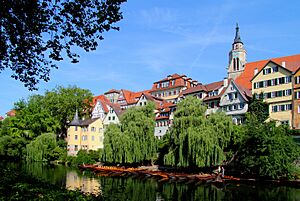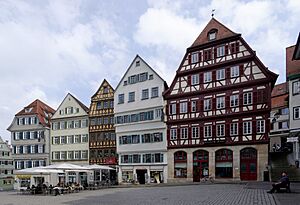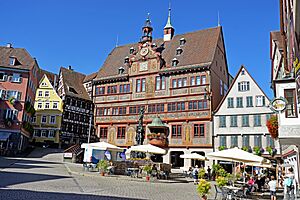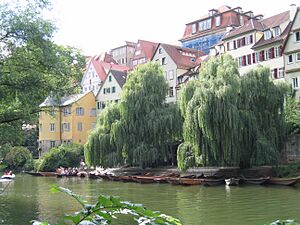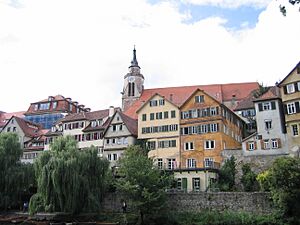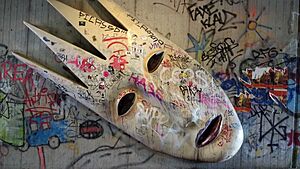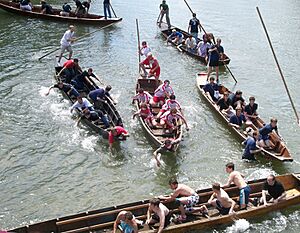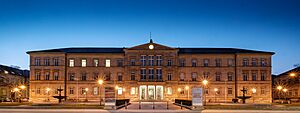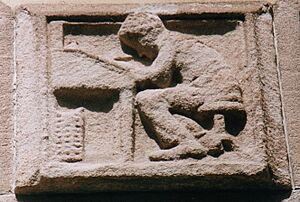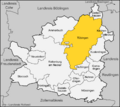Tübingen facts for kids
Quick facts for kids
Tübingen
Dibenga (Swabian)
|
||
|---|---|---|

Tübingen seen from above in June 2018
|
||
|
||
| Country | Germany | |
| State | Baden-Württemberg | |
| Admin. region | Tübingen | |
| District | Tübingen | |
| Elevation | 341 m (1,119 ft) | |
| Population
(2022-12-31)
|
||
| • Total | 92,811 | |
| Time zone | CET/CEST (UTC+1/+2) | |
| Postal codes |
72001–72099
|
|
| Dialling codes | 07071 07073 (Unterjesingen) 07472 (Bühl) |
|
| Vehicle registration | TÜ | |
| Website | www.tuebingen.de | |
Tübingen (German: [ˈtyːbɪŋən]; Swabian: Dibenga) is a cool university city in central Baden-Württemberg, Germany. It is about 30 kilometers (18 miles) south of Stuttgart, the state capital. The city grew up on both sides of the Neckar and Ammer rivers.
As of 2014, about one in three of the 90,000 people living in Tübingen are students. In the 2018/2019 winter semester, 27,665 students went to the Eberhard Karl University of Tübingen. The city has the youngest average age in Germany. This is partly because so many students live there. In 2015, the average age of a Tübingen citizen was 39.1 years.
Just north of the city is the Schönbuch, a forest that is now a nature park. The Swabian Alb mountains are about 13 kilometers (8 miles) to the southeast of Tübingen.
The Ammer and Steinlach rivers flow into the Neckar river. The Neckar flows east through the city, just south of the medieval old town. Many parts of the city are hilly. The Schlossberg and Österberg are in the city center. The Schnarrenberg and Herrlesberg are also close to the inner city.
The highest point in Tübingen is about 500 meters (1,640 feet) above sea level. This spot is near Bebenhausen in the Schönbuch forest. The lowest point is 305 meters (1,000 feet) in the city's eastern Neckar valley. The middle point of the state of Baden-Württemberg is in a small forest called Elysium. This forest is near the university's Botanical Gardens.
Contents
History of Tübingen
People probably first lived in this area around 12,000 BC. The Romans were here in AD 85. They built a frontier wall, called a limes, along the Neckar River. Tübingen itself started in the 6th or 7th century. At that time, the Alamanni people lived in the region. Some historians think the Battle of Solicinium happened at Spitzberg, a mountain in Tübingen, in AD 367. However, there is no clear proof of this.
Tübingen was first written about in official records in 1191. The local castle, Hohentübingen, has records from 1078. This was when Henry IV, the king of Germany, attacked it. The castle's name was written in Medieval Latin as Tuingia and Twingia.
From 1146, Count Hugo V became Count Palatine Hugo I. Tübingen became the main city of a special area called a County Palatine of Tübingen. By 1231, Tübingen was called a civitas. This meant the king recognized its civil rights and court system.
In 1262, a monastery for Augustinian monks was started in Tübingen. In 1272, a Franciscan monastery was also founded. In 1300, a Latin school began. Today, this school is called Uhland-Gymnasium. During the Protestant Reformation, Duke Ulrich of Württemberg became a Protestant. He closed the Franciscan monastery in 1535.
In 1342, the county palatine was sold to Ulrich III, Count of Württemberg. It then became part of the County of Württemberg.
Between 1470 and 1483, the St. George's Collegiate Church was built. This church helped lead to a very important event in Tübingen's history. In 1477, Duke Eberhard im Bart of Württemberg founded the Eberhard Karls University. This made it one of the oldest universities in Central Europe.
The university quickly became famous for learning, especially for theology. A Protestant theology school, Tübinger Stift, started in 1535 in the old Augustinian monastery. Today, the university is still the biggest source of jobs and money for the city. It is also one of the largest universities in Germany, with over 26,000 students.
Between 1622 and 1625, the Catholic League took over Lutheran Württemberg. This happened during the Thirty Years' War. In the summer of 1631, the city was attacked. In 1635 and 1636, the city was hit by the Plague. In 1638, Swedish soldiers took over Tübingen. Near the end of the war, French soldiers occupied the city from 1647 to 1649.
In 1789, parts of the old town burned down. But they were rebuilt to look like the original buildings. In 1798, the Allgemeine Zeitung newspaper was started in Tübingen by Johann Friedrich Cotta. This was a very important newspaper in Germany in the early 1800s. From 1807 to 1843, the poet Friedrich Hölderlin lived in a tower in Tübingen. This tower overlooked the Neckar river.
During the Nazi era, the Tübingen Synagogue was burned down. This happened on Kristallnacht, November 9, 1938. The Second World War did not damage the city much. This was mainly because a local doctor, Theodor Dobler, worked for peace. The French army occupied Tübingen and it became part of the French zone. From 1946 to 1952, Tübingen was the capital of the new state of Württemberg-Hohenzollern. Later, this state joined with others to form Baden-Württemberg. French troops stayed in the city until the end of the Cold War in the 1990s.
In the 1960s, Tübingen was a center of the German student movement. It was also a key place for the Protests of 1968. Since then, it has been known for its left and green political ideas. Some students from Tübingen supported a radical group. One active member, Gudrun Ensslin, was a student in Tübingen from 1960 to 1963.
On May 27, 1968, the first ever automated teller machine (ATM) in Germany was put in Tübingen. It was built into the wall of the local Kreissparkasse Tübingen bank. It was made by Ostertag AG and AEG-Telefunken. Only 1000 special clients of the bank could use it.
In the past, Tübingen was a city divided by wealth. Poor farmers and tradesmen lived near the Stadtgraben (City Canal). Students and professors lived around the old university buildings. On the Cottahaus, a sign remembers Goethe's short visit. A funny sign on the building next door, which was once a dorm, says "Hier kotzte Goethe" (meaning: "Goethe puked here").
In the second half of the 1900s, Tübingen grew. It added several small towns and villages. One important village is Bebenhausen. It has a castle and Bebenhausen Abbey, a Cistercian monastery. This village is about 2 kilometers (1.2 miles) north of Tübingen.
Life in Tübingen
In 2020, Tübingen had 90,000 people. Life in the city is greatly shaped by its roughly 28,000 students. Tübingen is a mix of old, respected academic traditions and modern liberal and green politics. It also has traditional German student fraternities. The area around it is rural and agricultural. The city is also known for Lutheran-Pietist values, like being careful with money and working hard. It also has typical Swabian traits, such as being thrifty, orderly, and neat. The city has many beautiful old buildings and sits on the River Neckar.
In 1995, a German magazine called Focus said Tübingen had the best quality of life in Germany. They looked at things like roads, bike paths, bus systems, and how easy it was to walk around the old town. They also considered cultural events from the university. Tübingen is the city with the youngest average population in Germany.
Cool Places to See
In central Tübingen, the Neckar river splits into two streams. This forms the long Neckarinsel (Neckar Island). It is famous for its Platanenallee, a path with tall plane trees that are about 200 years old. You can get to the island by stairs from a bridge or by a smaller footbridge. In summer, the Neckarinsel sometimes hosts concerts, plays, and readings. The old houses along one side of the island are called the Neckarfront. One house here has a tower where poet Friedrich Hölderlin lived for 36 years. He struggled with mental health during that time.
Tübingen's Altstadt (old town) was not damaged in World War II. This is because the city did not have heavy industries. Now, many visitors come to walk through one of the few fully intact historic old towns in Germany. Tübingen's old town has winding cobblestone lanes and narrow stairways that go up the hills. It also has streets with canals and well-kept traditional half-timbered houses.
Important old city landmarks include the city hall on Markt Square. There is also the Hohentübingen Castle, which is now part of the University of Tübingen. The main landmark is the Stiftskirche (Collegiate Church). This church was one of the first in the city to become a Protestant church. It still has some features from its Roman Catholic past, like patron saints. Below the Rathaus (city hall) is a quiet street called the Judengasse. This was the old Jewish neighborhood of Tübingen until the Jews were forced to leave in 1477. A plaque on the street corner remembers the history of Tübingen's Jews.
The center of Tübingen hosts weekly and seasonal events. These include market days on the Holzmarkt near the Stiftskirche and the Marktplatz by the Rathaus. There is also an outdoor cinema in winter and summer. The city has festive autumn and Christmas markets.
Students and tourists also go to the Neckar River in the summer. They visit beer gardens or go boating in Stocherkähne. These are like the Oxford and Cambridge punts, but slimmer. A Stocherkahn can carry up to 20 people. On the second Thursday of June, all Stocherkahn boats take part in a big race called the Stocherkahnrennen.
Bebenhausen Abbey is in the village of Bebenhausen, which is part of Tübingen. A path of the Way of St. James pilgrimage route starts here and goes through Tübingen.
Culture and Events
Tübingen has a lively arts scene and nightlife. Besides university events, the city has several choirs, theater groups, and nightclubs. Tübingen's Kunsthalle (art exhibition hall) shows two or three important international art exhibits each year.
Festivals and Fun
There are many festivals, outdoor markets, and other events happening regularly:
- January: Arab Movie Festival Arabisches Filmfestival
- April: Latin American Movie Festival CineLatino (sometimes in May)
- May: Internationales Pianisten-Festival (international festival of pianists), Rock Festival Rock im Tunnel (sometimes in June)
- June:
* Poled boat race (German: Stocherkahnrennen), on the second Thursday of June at 2 pm, around the Neckar Island. * Ract!festival, a free outdoor festival with music and workshops. * Tübinger Wassermusik: concerts on Stocherkahn boats.
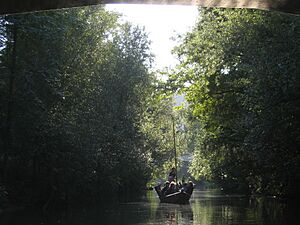
- July:
* Stadtfest: food and performances in the old town streets. * Tübinger Sommerinsel festival: restaurants serve special meals, and groups offer activities on the Neckar Island.
- August:
* Tübinger Orgelsommer: organ concerts in the Stiftskirche. * Sommerkonzerte in the old monastery of Bebenhausen (July-September). * Kennen Sie Tübingen? (Do you know Tübingen?): special guided tours on Mondays from July to September.
- September:
* Vielklang: classic music concerts at different places. * Umbrisch-Provenzalischer Markt, an outdoor market for Italian and French products. * Tübinger Stadtlauf, the city's 10km race. * Retromotor oldtimer festival (usually second or third September weekend).
- October:
* Jazz- und Klassiktage: jazz and classic music festival. * Kite festival Drachenfest on the Österberg hill (usually third Sunday in October). * French movie festival Französische Filmtage.
- November: Terre de femmes movie festival FrauenWelten.
- December:
* Nikolauslauf half marathon outside Tübingen in the forest. * Die Feuerzangenbowle film and a large amount of Feuerzangenbowle drink made in a public square. * Chocolate festival chocolART. * Christmas market.
Population Growth
Since World War II, Tübingen's population has almost doubled. It went from about 45,000 to 88,000 people. This is also because some villages joined the city in the 1970s.
The current mayor, Boris Palmer, wants to increase the population to 100,000 people. To do this, the city is building new houses in empty spaces between existing buildings. This also helps stop cities from spreading out and using up too much land.
Climate in Tübingen
Tübingen has an oceanic climate. This means it has mild winters and warm summers. It gets rain throughout the year.
Sister Cities
Tübingen is connected with other cities around the world. These are called sister cities:
 Monthey, Switzerland (1959)
Monthey, Switzerland (1959) Aix-en-Provence, France (1960)
Aix-en-Provence, France (1960) Kingersheim, France (1963)
Kingersheim, France (1963) Ann Arbor, United States (1965)
Ann Arbor, United States (1965) Durham, England, UK (1969)
Durham, England, UK (1969) Aigle, Switzerland (1973)
Aigle, Switzerland (1973) Kilchberg, Switzerland (1981)
Kilchberg, Switzerland (1981) Perugia, Italy (1984)
Perugia, Italy (1984) Petrozavodsk, Russia (1989)
Petrozavodsk, Russia (1989) Villa El Salvador, Peru (2006)
Villa El Salvador, Peru (2006) Moshi, Tanzania (2014)
Moshi, Tanzania (2014)
The Council of Europe gave Tübingen and Aix-en-Provence the Europe Prize in 1965. This was for their work in international partnerships. The city also shows its dedication to European understanding by naming streets and squares after Europe. An example is the large Europaplatz (Europe Square) outside the railway station.
Getting Around Tübingen
By Plane
Tübingen is about 35 kilometers (22 miles) from the Stuttgart Airport.
By Car
Tübingen is on the Bundesstraße 27, a main federal road. This road connects the city with Würzburg, Heilbronn, Stuttgart, and the airport to the north. It also connects to Rottweil and Donaueschingen to the south.
By Train
Tübingen Hauptbahnhof (main train station) is on a regional train line. This line goes from Stuttgart Hauptbahnhof through Esslingen and Reutlingen to Tübingen. A trip to Stuttgart usually takes about an hour, but some trains are faster. Other regional lines connect Tübingen to Hechingen, Sigmaringen, Herrenberg, and Horb. Since 2009, there is also a daily direct Intercity train. This train goes to Mannheim, Cologne, Düsseldorf, and Berlin.
Local Buses
Because many students live here, Tübingen has a large public bus network. There are more than 20 lines that connect city districts and nearby places. These include Ammerbuch, Gomaringen, and Nagold. There are also night bus lines that run every day in the early morning hours. A direct bus goes to Stuttgart Airport. You can also take buses to Böblingen and Reutlingen.
Sports in Tübingen
Tigers Tübingen is the city's only professional sports team. They play basketball.
Learning and Research
University and Research Centers
The Eberhard Karls University of Tübingen started in 1477. This makes it one of the oldest universities in Germany. Including its hospitals, it is also the biggest employer in the city. Tübingen is also home to several research institutes. These include the Max Planck Institutes for Biological Cybernetics, Developmental Biology, and Intelligent Systems. There is also the Friedrich Miescher Laboratory of the MPG and the Max Planck Institute for Biology. Other centers include the Hertie Institute for Clinical Brain Research and the Werner Reichardt Centre for Integrative Neuroscience.
A modern technology park is growing in the north of the city. Here, scientists, companies, and new businesses work together. They mainly focus on biotechnology and artificial intelligence. The university also has a botanical garden, the Botanischer Garten der Universität Tübingen. Plus, there is a Protestant College of Church Music.
Schools in Tübingen
More than 10,000 children and young adults go to school in Tübingen. There are 30 schools in the city. Some schools have different types of education. There are 17 primary schools. For secondary education, there are four Hauptschule (lowest rank), three Realschule (middle rank), and six Gymnasien (grammar schools). Tübingen also has four vocational schools (Berufsschule) and three special needs schools.
Primary schools
- Freie Aktive Schule Tübingen
- Grundschule Innenstadt / Silcherschule
- Grundschule Weilheim
- Ludwig-Krapf-Schule
- Grundschule Hügelstraße
- Französische Schule
- Dorfackerschule Lustnau
- Grundschule Hirschau
- Grundschule Hechinger Eck
- Grundschule auf der Wanne
- Grundschule Aischbach
- Grundschule Winkelwiese / Waldhäuser Ost
- Grundschule Bühl
- Grundschule Kilchberg
- Grundschule Hagelloch
- Grundschule Pfrondorf
- Grundschule Unterjesingen
Hauptschulen
- Dorfackerschule Lustnau
- Mörikeschule
- Geschwister-Scholl-Schule
- Hauptschule Innenstadt
Realschulen
- Walter-Erbe-Realschule
- Albert-Schweitzer-Realschule
- Geschwister-Scholl-Schule
Gymnasien
- Carlo-Schmid-Gymnasium
- Geschwister-Scholl-Schule
- Kepler-Gymnasium
- Uhland-Gymnasium
- Wildermuth-Gymnasium
- Freie Waldorfschule
Vocational schools (Berufsschulen)
- Gewerbliche Schule
- Wilhelm-Schickard-Schule
- Mathilde-Weber-Schule
- Bildungs- und Technologiezentrum
Famous People from Tübingen
Many notable people have lived in or come from Tübingen:
- Johann Friedrich Cotta (1764–1832), a famous publisher and politician.
- Ludwig Uhland (1787–1862), a poet, lawyer, and politician.
- Friedrich Silcher (1789–1860), a composer.
- Hermann Hesse (1877–1962), a poet, novelist, and painter. He won the Nobel Prize in Literature in 1946.
- Boris Palmer (born 1972), the current mayor of Tübingen.
- Dieter Baumann (born 1965), an Olympic gold and silver medalist in track and field.
- Thilo Kehrer (born 1996), a football player for the national team.
Famous People from Tübingen University
Many important people studied at the University of Tübingen:
- Johannes Kepler (1571–1630), a famous astronomer and mathematician.
- Wilhelm Schickard (1592–1635), who invented the world's first mechanical calculator.
- Georg Wilhelm Friedrich Hegel (1770–1831), a well-known philosopher.
- Friedrich Hölderlin (1770–1843), a poet and philosopher.
- Lothar Meyer (1830–1895), a chemist who helped create the periodic table.
- Ferdinand Braun (1850–1918), an inventor and professor who won the Nobel Prize in Physics in 1909.
- Alois Alzheimer (1864–1915), a psychiatrist who discovered Alzheimer's disease.
- Albert Schweitzer (1875–1965), a humanitarian and doctor who won the Nobel Peace Prize in 1952.
- Dietrich Bonhoeffer (1906–1945), a Lutheran theologian and anti-Nazi activist.
- Christiane Nüsslein-Volhard (born 1942), a biologist who won the Nobel Prize in Physiology or Medicine in 1995.
- Horst Köhler (born 1943), who was the President of Germany from 2004 to 2010.
- Pope Benedict XVI (1927–2022), who was a professor of theology at the university.
Images for kids
See also
 In Spanish: Tubinga para niños
In Spanish: Tubinga para niños



